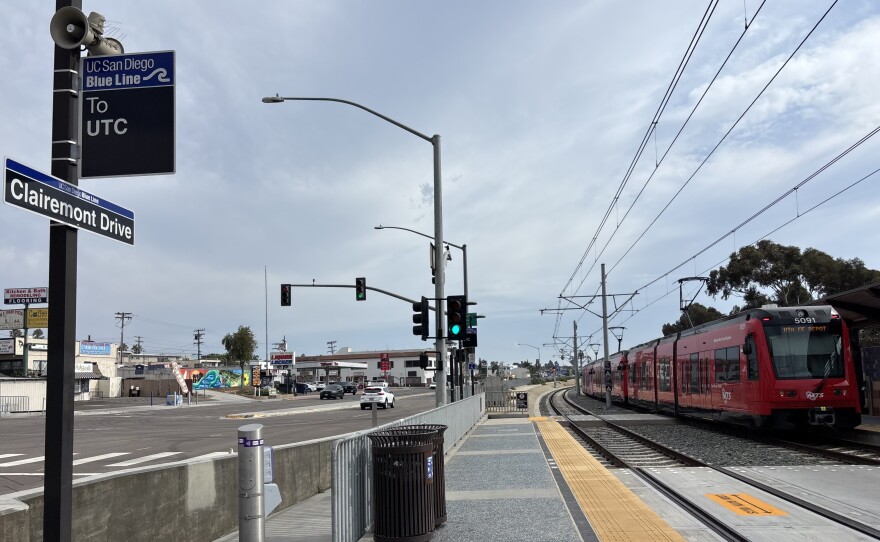San Diego's restrictions on development near trolley stations could be contributing to the financial struggles of the Metropolitan Transit System, according to a KPBS analysis of MTS ridership data.
San Diego's trolley network consistently ranks among the most popular light rail systems in the country. MTS recently reported 42.6 million trolley trips in the most recent fiscal year, up from 39.6 million in the year prior.
The Blue Line is the network's most popular by far — though some of its stations see the lowest ridership of the entire trolley network.
KPBS obtained a dataset showing the average weekday boardings of every MTS trolley station for the past seven years. The network's two least popular stations were Gillespie Field, which has been dubbed the worst rail station in California, and the Stadium Station, where ridership is dependent on special events at Snapdragon Stadium.
The station with the third-lowest weekday ridership was the Clairemont Drive Station, which opened four years ago as part of the $2 billion Mid-Coast Trolley extension.
Ethan Elkind, climate director at UC Berkeley's Center for Law, Energy and the Environment, said San Diego's push to preserve low-density housing near the Clairemont Drive Station is limiting its ridership potential, and that allowing more apartments nearby could help lift MTS out of its budget deficit.
"It's a way to accommodate new residents in a much more sustainable manner and help shore up the finances of these transit systems, which are facing fiscal cliffs all across the country," Elkind said. "It's not enough just to build rail. You have to make sure that the local governments that have land use authority are allowing apartments to be built around the rail transit stops."
On paper, the Clairemont Drive Station has the potential for high ridership. It's a short distance from Mission Bay Park — though getting to the park requires a long and unpleasant walk over the I-5 freeway.
To the station's east is a mix of vacant lots, aging commercial properties and low-density housing. The city rezoned a handful of those properties for higher density in 2019, though housing permit data show the rezoning has delivered little if any new housing. A planned development on a large vacant lot across the street from the Clairemont Drive Station has been stalled for more than three years.
A draft update to the Clairemont Community Plan would further increase density on properties near the Clairemont Drive Station that already allow apartments. But most of the land within walking distance to the trolley would remain zoned for single-family homes.
Elkind authored a study in 2015 that found San Diego has some of the least walkable rail stations in California. He said when city planners try to force transit-oriented development into a small area, as they've done near the Clairemont Drive Station, it can lead to speculation and bidding wars that produce less affordable housing.
"Since you're artificially suppressing the supply of apartments, you're now creating a concentrated amount of demand, like focusing the sunlight in a magnifying glass on one parcel or a series of parcels around the station area," Elkind said. "So you're more likely to get just high-end type housing rather than … more affordable types of apartment units."
The MTS trolley data also shows how building high-density housing adjacent to stations can pay big dividends in terms of ridership. The Grantville Station on the Green Line saw a 65% increase in boardings after MTS partnered with developers to build two apartment projects on the station's parking lot.
City Planning Director Heidi VonBlum said the city is preserving single-family zoning near the trolley stations because those properties are smaller and less likely to be redeveloped.
"When we're proposing updates (to community plans), we look at feasibility for the redevelopment to occur," VonBlum said. "When parcels are smaller … it's less likely that we'll see that redevelopment occur."
Elkind agreed that simply zoning for higher density doesn't necessarily produce more housing. But he disagreed that smaller properties near the trolley are unlikely to redevelop, given the area's high home values and proximity to good schools, jobs, parks and public transit.
"Where upzoning can deliver projects is in areas of very high demand, so upscale communities," Elkind said. "If you can upzone in those areas, developers know even if the land costs more, they can get a higher return per square foot on their investment."








